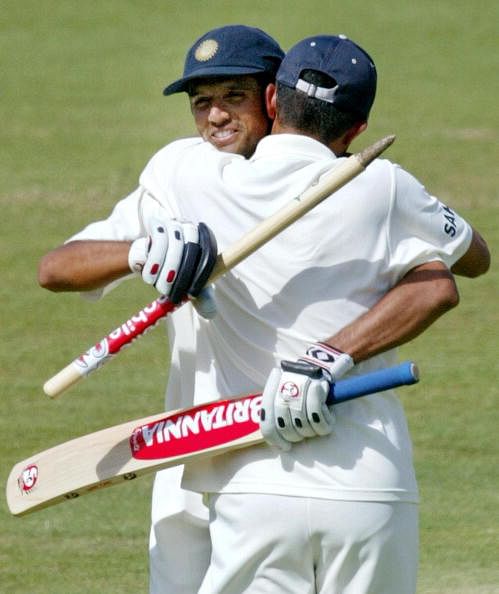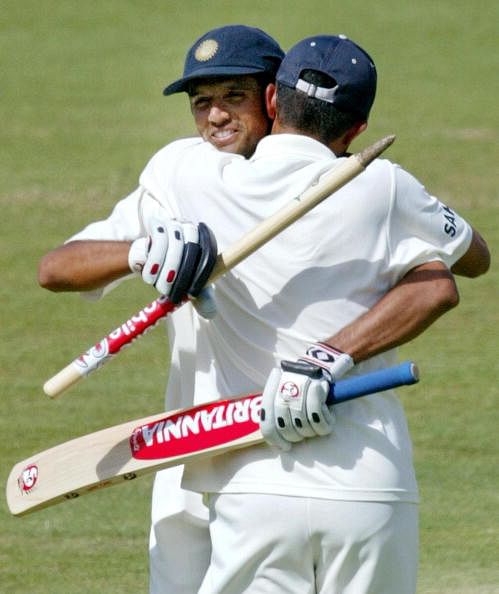
Revisiting Indian cricket between 2000-2005

Rahul Dravid (facing) is congratulated by Sourav Ganguly after pulling off a historic Test win in Australia in 2003
This phase was right after the match-fixing episode that dented our cricketing image in a big way. So, it took time for the wounds to heal and for a charismatic leader to take over the reins from Tendulkar, who wasn’t enjoying captaincy and the pressure of ONE-MAN army that India was tagged as in those days.
Ganguly was developing as a player having been at the international arena for quite sometime and nobody seemed to recognize him as a captaincy material, as much as a Kohli has been in the best part of last 18 months.
But then, things transpired and Ganguly became the captain that India essentially required. Although he didn’t have the greatest of starts to his captaincy career, he redeemed himself and to also lead a team that boasted of an imperious Tendulkar, canny Kumble, a serene Dravid and an emerging VERY VERY SPECIAL (VVS) Laxman, Ganguly had the substance to take the team forward.
To justify quality in the team, Ganguly managed to lead India to a historic home series win against the Kangaroos in 2001. This series win brought life and belief to Indian cricket and its humongous supporters.
The 2001 Border-Gavaskar trophy triumph was no walk in the park, as we had to overcome an Australian side that was dismantling their opponents with disdain. Prior to that series, not a lot of them gave India a chance, which added furthermore glory to this epic tale and transformed Indian cricket for the good.
Not only did Ganguly bring winning habit and consistency to the team, his aggressive demeanor and captaincy style went a long way in changing the way we played our cricket during his captaincy tenure and the manner in which we play our cricket today.
Just like partnerships on a cricket pitch that help teams win matches, the partnership between John Wright and Ganguly outside the field helped India in the longer run. John Wright played the perfect foil for someone like Ganguly and ensured that the team stayed together.
Defying odds became the trend in the early half of the first decade. The 2002 Natwest series win was another monumental achievement engraved in Indian cricketing history which, even today will stimulate tears in the eyes of those passionate Indian cricket followers. In Mohammad Kaif and a certain hard-hitting Yuvraj Singh, India unearthed two of India’s up-and-coming talents.
Right after the win, most of Indian fans witnessed something that has been etched in a lot of their memories. Something that denoted VENGEANCE, something that denoted the personification of AGGRESSIVENESS. Ganguly taking off his shirt in response to Flintoff’s similar gesture in Mumbai, prior to that series, did have scrutiny and controversy attached to it but this act on Lord’s dressing room certainly sent a strong signal to the cricketing world of what was to come.
Post the dramatic Natwest series win, India didn’t have the perfect road in the build up to the World Cup in 2003. We lost despairingly to the Black Caps in their own den and people doubted India’s world cup ambitions.
But contrary to all their detractors, India did go the distance in the championship tournament. Unexpectedly, when the chips were down and public’s faith in the team was its nadir, Ganguly and co. played some brilliant cricket to reach the final of the tournament. Barring Australia, India were clearly the second best team in the tourney, but hopes of lifting the World Cup after 20 years fizzled out when the mighty Australians outmuscled the Indian team in the final.
Throughout these five years, India continued to go from strength to strength. Not only did Ganguly play his role as a captain well but he was instrumental in players like Harbhajan, Sehwag, Zaheer Khan and Yuvraj Singh- all of them have continued to be top-draw performers for India.
The next big hurdle in India’s way was the tour to Down Under. Indian side again looked an organised one and a team that meant business. Dada stood tall in the first Test at the ‘Gabba to steer India to a draw with a nicely compiled 144.
In the second Test at the Adelaide Oval, Ricky Ponting made a brilliant double hundred and almost put the match out of sight for India. At one stage in the Indian innings, the scorecard read 86-4. And like many other times, Dravid and Laxman stood firm to smother the Australian attack, and lay a platform for a famous Indian win.
The series ended 1-1 and yet again reiterated the impact of Dada’s captaincy for showing the way to win test matches abroad.
In 2004, India defeated their fiercest rivals in Pakistan and registered their first ever Test series win in Pakistan.
To pull the curtains on this article, a large part of Indian cricket’s status today has to be owed to the way Dada built the team and brought in changes. Yes, we are at our imperious best in the limited overs format now and not far behind when it comes to Test match cricket but, I am firm believer that, Dada built the team and Mahi has cashed in on the resources.
The period between 2000-2005 is the one that turned Indian cricket for the good.